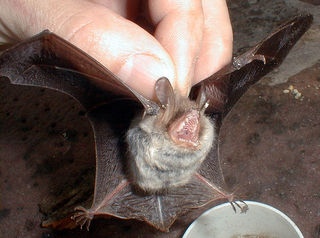
Natterer's bat
Order : Chiroptera
Family : Vespertilionidae
Subfamily : Vespertilioninae
Species : Myotis nattereri
The Natterer's bat is listed as Least Concern (LR/lc), lowest risk. Does not qualify for a more at risk category. Widespread and abundant taxa are included in this category, on the IUCN Red List of Threatened Species
Namings for the Natterer
A young / baby of a Natterer is called a 'pup'. A Natterer group is called a 'colony or cloud'.Countries
Armenia, Austria, Azerbaijan, Belarus, Belgium, Bulgaria, China, Czech Republic, Denmark, Finland, France, Georgia, Germany, Greece, Hungary, Iran, Iraq, Ireland, Israel, Italy, Japan, Jordan, Korea, North, Latvia, Lebanon, Luxembourg, Mongolia, Morocco, Netherlands, Poland, Portugal, Romania, Russia, Serbia and Montenegro, Slovakia, Slovenia, Spain, Sweden, Switzerland, Turkey, Turkmenistan, Ukraine and United KingdomSome facts about the
Natterer's bat
Adult weight : 0.008 kg (0.0176 lbs)
Maximum longevity : 20 years
Weaning : 60 days
Litter size : 1
Interval between litters : 365 days
Facts about the Natterer's bat
Daubenton's and Natterer's bats are most frequently recorded hibernating in caves and other underground structures.
Habitat Natterer's bats are very common throughout all of Europe and western Russia, up to the Arctic Circle.
In addition, Natterer's Bat is a specially protected and endangered species according to the Nature Conservation Statute and Pond Bat under Annex II of the Nature Directive.
Long-eared and Natterer's bats are both "gleaners" as well as "aerial hawkers"; they take large numbers of stationary moths from foliage or other surfaces, and they also hunt their prey in flight.
Myotis nattereri - Natterer's Bat Natterer's bat is a fairly common species in the British isles.
Myotis nattereri is found from Northern Greece south to the Peloponnesos.
Natterer's Bat Distribution map Rather like Whiskered/Brandt's, records of Natterer's bats are widely but
Natterer's bats are found in wooded areas, parks and along riversides.
Rather like Whiskered/Brandt's, records of Natterer's bats are widely but thinly distributed.
Schnitzler Natterer`s bat (Myotis nattereri) is specialized in foraging for insects that are flying close to vegetation.
The Natterer's bat is named after an early 19th century Austrian naturalist who discovered it.
When over water, Natterer's bats are reported usually to fly higher than Daubenton's bats.
htm'); CallAdv(); CreateTd(21) Natterer's Bat and Man Like all species of bat in Britain, the Natterer's bat is less common than it used to be. (Full text)
De franjestaart (Myotis nattereri) is een vleermuis uit de familie der gladneuzen. (Wiki)
Swift Natterer’s bat, Myotis nattereri, is one of the less researched Scottish species, and data on its behaviour are still (Full text)
back to topRange Widespread in much of Europe, Natterer's bat is found throughout most of the British Isles north to the Great Glen Fault in Scotland, but is scarce throughout most of this range (2). (Full text)
Bats are usually to be found in the crevices provided, but occasionally an individual such as this Natterer’s bat is found hibernating in the open. (Full text)
The Natterer’s bat is a medium sized species with relatively long ears. (Full text)
Natterer's bat (Myotis nattereri) is a medium-sized species. (Full text)
Natterer's bats are found throughout most of the British Isles. (Full text)
Natterer's bat (Myotis nattereri) The Natterer's bat is similar to the Daubenton's, and individuals have been found in Highgate Woods and the grounds of Chiswick House and in 1996 a tree roost was found in (Full text)
More animals beginning with N
